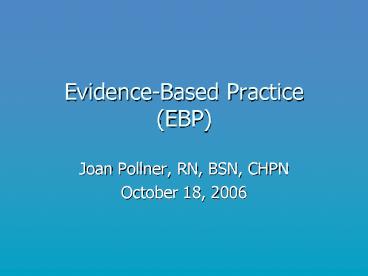EvidenceBased Practice EBP - PowerPoint PPT Presentation
1 / 18
Title:
EvidenceBased Practice EBP
Description:
( Chitty, 2005). Goals of EBP. Provide practicing nurses with evidence-based data ... Chitty, K.K. (2005). Professional nursing: Concepts and challenges. ... – PowerPoint PPT presentation
Number of Views:695
Avg rating:3.0/5.0
Title: EvidenceBased Practice EBP
1
Evidence-Based Practice(EBP)
- Joan Pollner, RN, BSN, CHPN
- October 18, 2006
2
Objectives
- Define Evidence-based practice (EBP)
- Identify the goals of EBP
- Distinguish between the characteristics of
Research Utilization and EBP - Describe the steps in the EBP process
- Explain the challenges and misconceptions of EBP
- Utilize resources to further knowledge of EBP
3
Some Definitions
- Evidence-based practice can be thought of as
requiring "the integration of the best research
evidence with our clincial expertise and our
patient's unique values and circumstances."
(Straus, et al., 2005) "Fortunately,
evidence-based practice (EBP) is an approach that
enables clinicians to provide highest quality of
care in meeting the multifaceted needs of their
patients and families." (Melnyk
Fineout-Overholt, 2005) (Yale, 2005)
4
Definitions (cont)
- Integration of the best research evidence with
clinical expertise and patient values. (Spector,
n.d.). - using the best available research findings to
make clinical decisions that are most effective
and beneficial for patients. (Chitty, 2005).
5
Goals of EBP
- Provide practicing nurses with evidence-based
data - Resolve problems in the clinical setting
- Achieve excellence in care delivery
- Introduce innovation
- Reduce variations in nursing care
- Assists with efficient and effective
decision-making
6
Goals (cont)
- Using best evidence to implement the regulation
of nurses - Resolve regulatory problems
- Achieve excellence in regulation
- Introduce regulatory innovation
7
Research Utilization vs EBP
- Research Utilization
- Use results of studies
- Randomly selected
- Support nursing care
- Less systematic
- Evidence-Based Practice
- Considers all research
- Utilized thorough integrative review
- Context of clinical expertise and value system of
the patient - More systematic
8
EBP is multi-step process
- Define patient problem
- Identify information needed to solve problem
- Search of literature
- Critical appraisal of the evidence
- Extraction of the clinical answer
- Protocol development
- Evaluation
9
Stevens ACE Star Model
- Discovery
- Summary
- Translation
- Implementation
- Evaluation
10
Stevens ACE Star ModelDiscovery
- Original research
- Conduct a literature search utilizing recognized
techniques
11
Stevens ACE Star ModelSummary
- Synthesize all research into a single meaningful
whole - This step differentiates research utilization
from Evidence-based practice - Can be called evidence synthesis
- Increase power and effect of data
- Reduce bias
- Assess consistencies
- Establish generalizability
- Reduce data into an manageable form
12
Stevens ACE Star ModelTranslation
- Scientific evidence is considered in the context
of clinical expertise and values - Results in clinical practice guidelines, best
practices, protocols, standards or clinical
pathways
13
Stevens ACE Star ModelImplementation
- Translation of research into practice
- Where changes take place
14
Stevens ACE Star ModelEvaluation
- Impact of the change is measured
- Assess variables (health outcomes, efficiency,
cost or satisfaction)
15
Challenges and Misconceptions
- Merely a collection of statistics?
- Need more qualitative research
- Nurses need to develop good search strategies
- Nurses must learn to do critical appraisals
- Faculty members must embrace and learn EBP
16
Resources
- Yale University Nursing Library and Information
Resources - http//www.med.yale.edu/library/nursing/education/
ebhc2.html - Oncology Nursing Society
- http//onsopcontent.ons.org/toolkits/evidence/
- United States Department of Health and Human
Services Agency for Healthcare Research and
Quality - http//www.ahrq.gov/clinic/epcix.htm
- University of Iowa Hospitals and Clinics Nursing
Services and Patient Care - http//www.uihealthcare.com/depts/nursing/rqom/evi
dencebasedpractice/index.html
17
Resources (cont)
- University of Texas Health Science Center at San
Antonio Acedemic Center for Evidence-Based
Practice - http//www.acestar.uthscsa.edu/About.htm
- Medical Library Association Nursing and Allied
Health Resources Section - http//nahrs.library.kent.edu/resource/symposium/
- University of Minnesota Evidence-based Health
Care Project - http//evidence.ahc.umn.edu/ebn.htm
18
References
- Chitty, K.K. (2005). Professional nursing
Concepts and challenges. 4th ed. Philadelphia
Saunders. - Spector, N. (n.d.). Evidence-Based Health Care
in Nursing Regulation. Retrieved on October 8,
2006 from Nation Council of State Boards of
Nursing web site on World Wide Web - http//www.ncsbn.org/pdfs/Evidencebased_NSpector.p
dfsearch22evidence20based20practice20in20nu
rsing22 - Yale University. (2005). Evidence-Based
Practice. Nursing Library and Information
Resources. Retrieved on October 8, 2006 from
World Wide Web http//www.med.yale.edu/library/n
ursing/education/ebhc2.html































